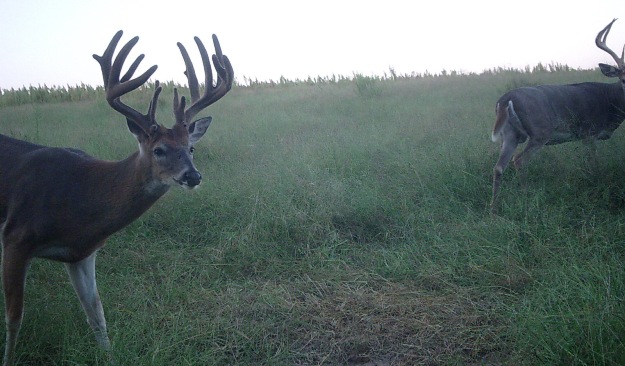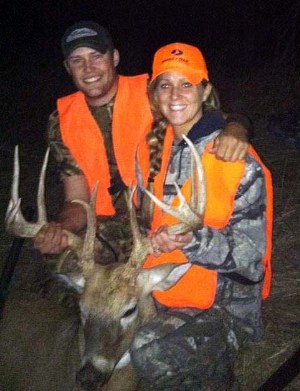
I was scouting an area where a pasture met an alfalfa field, and there was a fence line between the two - three cottonwood trees in a row on the fence line and the rest open land. I spotted several bucks around these trees before I was leaving on a trip to hunt in Canada. So, I decided to put out trail cameras and some corn to see if I could get pictures of these bucks that I was seeing from the road. When I returned from Canada, I checked my trail cameras and had pictures of a buck still in velvet and another buck in hard antler that had double-drop tines. I wanted to try to take the buck with the drop tines, because I never had shot a buck with drop tines. However, when I checked my other 13-trail cameras, I had pictures of the drop-tine buck on all the other cameras. The drop-tine buck was the most unpatternable buck I’d ever encountered. So, I knew he would be tough to take.
When hunting season arrived, so did the chiggers. I was in my tree stand with my pants rolled up to my knees, scratching chigger bites. The temperature was about 90 degrees. I saw the velvet- antlered buck with two does coming my way on this second day of bow season. I texted my buddy from my tree stand when I saw the velvet buck with his does and said, “I’ve got to go. I see the velvet-antlered buck, and he is coming toward me.” I looked at my watch and knew I had only 10-15 minutes of daylight before legal shooting time was over. I was really surprised that the buck hadn’t shed any velvet at all. The bucks in our area usually have completely shed their velvet before bow season, or they may just have a little bit of velvet hanging off their antlers. I quickly texted my buddy again and asked, “Do you think I should shoot the velvet-antlered buck?” My friend texted back, “Let him have it.” When the buck came within bow range, I released my arrow, and he didn’t run 30-40 yards before he bowed up. The buck scored around 160 points.
The latest I’ve ever taken a buck was on November 3rd one year. Since I sell real estate during October and November, I have a lot of hunters coming into my Mossy Oak Properties’ real-estate office, looking for hunting land to purchase. So, by hunting early in bow season, I usually take the buck I want to take in the first 2 weeks of the season and find a buck for my girlfriend too. I start hunting on opening day of bow season, which in 2016 will be September 12th. I took my buck that scored 193 points on September 17th one year and I took the velvet-antlered buck on September 18th another year. I’ve also helped my girlfriend find and take her bucks in less than 24 hours of hunting for the last 5 years. By using the system of scouting that I do, Annie and I usually can tag out within the first 2 weeks of bow/ blackpowder season. Then I have plenty of time to show hunters properties for sale during October, November and December.
 This November hunt when I took a buck on November 3rd happened during the first few years when I was trying to grow my real-estate business. I had to put in as much time as I could to grow my Mossy Oak Properties business, and I didn’t have as many trail cameras as I do now. Back then I didn’t have enough money to buy many trail cameras. But once again the biggest deer I had pictures of from the trail cameras I had out, I had to wait for, since the only trail-camera pictures I had for this deer were at night. Once I had some time on an afternoon in November, I snuck in to one of my tree stands that I had put up close to the bedding area. My plan was to try to take this buck when he was leaving his bedding area just before dark and headed to the agricultural field to feed. This buck was unusual because his brow tines were about 7-8 inches long. On the day I hunted him, I spotted those long brow tines coming out of the tall grass where this buck had been bedded, headed straight to me. I knew he was a big buck. I only had a few minutes to calm myself down and prepare for the shot. The buck came in exactly where I thought he would, and when he was 25-yards away, I released the arrow. I watched the arrow in flight, saw it hit the buck and knew I had double-lunged him. However, I couldn’t believe my eyes when the buck ran about 150 yards, stopped and looked back at my tree stand as if to say, “Ha-ha you didn’t even hit me.” Then he walked off. I got out of my tree stand and went to the spot where I arrowed the buck. There was no blood and no arrow, and I didn’t see any indication that my arrow had hit that buck on the ground. But as I replayed the shot in my mind, I knew I had made a lethal hit, even though the signs to prove that fact weren’t on the ground.
This November hunt when I took a buck on November 3rd happened during the first few years when I was trying to grow my real-estate business. I had to put in as much time as I could to grow my Mossy Oak Properties business, and I didn’t have as many trail cameras as I do now. Back then I didn’t have enough money to buy many trail cameras. But once again the biggest deer I had pictures of from the trail cameras I had out, I had to wait for, since the only trail-camera pictures I had for this deer were at night. Once I had some time on an afternoon in November, I snuck in to one of my tree stands that I had put up close to the bedding area. My plan was to try to take this buck when he was leaving his bedding area just before dark and headed to the agricultural field to feed. This buck was unusual because his brow tines were about 7-8 inches long. On the day I hunted him, I spotted those long brow tines coming out of the tall grass where this buck had been bedded, headed straight to me. I knew he was a big buck. I only had a few minutes to calm myself down and prepare for the shot. The buck came in exactly where I thought he would, and when he was 25-yards away, I released the arrow. I watched the arrow in flight, saw it hit the buck and knew I had double-lunged him. However, I couldn’t believe my eyes when the buck ran about 150 yards, stopped and looked back at my tree stand as if to say, “Ha-ha you didn’t even hit me.” Then he walked off. I got out of my tree stand and went to the spot where I arrowed the buck. There was no blood and no arrow, and I didn’t see any indication that my arrow had hit that buck on the ground. But as I replayed the shot in my mind, I knew I had made a lethal hit, even though the signs to prove that fact weren’t on the ground.
I walked down the trail about 50 yards and got upset with myself, thinking my eyes had played tricks on me, and that I must have missed the deer. I felt sick to my stomach. I called my dad to tell him what I had done, and he said, “Just relax, come home, and you and I will go look for him tomorrow.” So, the next morning, my dad who is a game warden, and I walked out the trail to where the buck had stopped and looked back at me and found two pools of blood. My dad walked 40 more yards down the trail and found my double-lunged buck. Apparently the buck had bled a lot after the arrow hit him. That buck scored 168 on Boone & Crockett.
I enjoy finding and trying to take the biggest buck on the 3,000 acres I hunt and also locating an older-age-class whitetail for my girlfriend Annie. Muzzleloader and bow seasons arrive at the same time, so she took her first four bucks at less than 60 yards, while logging less than 24 hours in tree stands to take each buck. Annie has tagged out the first time she’s sat in a stand each season, while only hunting in the afternoons. Most of her bucks have been harvested within the last 30 minutes of shooting time. Annie has taken a 160 buck and two, 150-point bucks.
What helps Annie and I to be so successful is we study maps long before we hunt, whether on public or private lands. Too, we use trail cameras to find as many bucks as possible on the property we hunt and use deer lure or bait. You can use whatever is legal in your state to attract deer to the place where you want to take him. Learn from the photos you’ve gotten what time the deer you want to take shows up at your stand site and then hunt the first day of archery season, which is usually hot weather in most of the United States. However, the first week of bow season is when I’ve found older-age-class bucks to be the most patternable - moving late in the afternoon and at night. Also if you scout agricultural fields from the road with binoculars or a spotting scope during the summer months and locate mature bucks that you may want to take, those bucks usually won’t be bedded-down very far from the fields where they feed. I always tell my dad if I can see a buck I want to take from the road, I believe I can take that buck in the first 2 weeks of bow season because those deer don’t want to walk far to eat dinner.
Day 4: Ryan Koelsch Passes Up a 170 Buck for Three Years






























